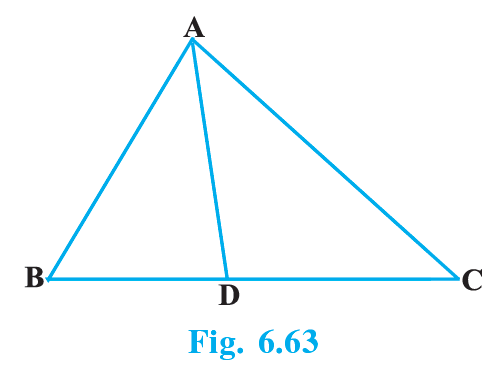In Fig. 6.63, D is a point on side BC of ∆ABC such that BD/CD = AB/AC. Prove that AD is the bisector of ∠BAC

Solution:
Let's extend BA to E such that AE = AC and join CE.

In ∆AEC
AE = AC
⇒ ∠ACE = ∠AEC ......(i) [Angles opposite to equal sides are equal]
It is given that
BD/CD = BA/CA
BD/CD = BA/AE [Since, AC = AE] .......(ii)
In ∆ABD and ∆EBC
AD || EC (Converse of Basic Proportionality Theorem)
⇒ ∠BAD = ∠BEC (Corresponding angles) .......(iii)
and ∠DAC = ∠ACE (Alternate interior angles) .......(iv)
or ∠DAC = ∠AEC [From (i) and (iv)] ......... (v)
From (iii) and (v),
∠BAD = ∠DAC
Thus, AD is the bisector of ∠BAC
☛ Check: NCERT Solutions for Class 10 Maths Chapter 6
Video Solution:
In Fig. 6.63, D is a point on side BC of ∆ABC such that BD/CD = BA/CA. Prove that: AD is the bisector of ∠BAC
NCERT Class 10 Maths Solutions Chapter 6 Exercise 6.6 Question 9
Summary:
In the above figure, D is a point on side BC of ∆ABC such that BD/CD = BA/CA. Hence proved that AD is the bisector of ∠BAC.
☛ Related Questions:
- In Fig. 6.56, PS is the bisector of ∠QPR of ΔPQR. Prove that QS/SR = PQ/PR.
- In Fig. 6.57, D is a point on hypotenuse AC of ΔABC , such that BD ⊥ AC, DM ⊥ BC and DN ⊥ AB. Prove that: (i) DM² = DN.MC (ii) DN² = DM.AN.
- In Fig. 6.58, ABC is a triangle in which ∠ABC > 90° and AD ⊥ CB produced. Prove that: AC² = AB² + BC² + 2BC.BD.
- In Fig. 6.59, ABC is a triangle in which ∠ABC less than 90° and AD ⊥ BC. Prove that: AC² = AB² + BC² - 2BC × BD.
visual curriculum